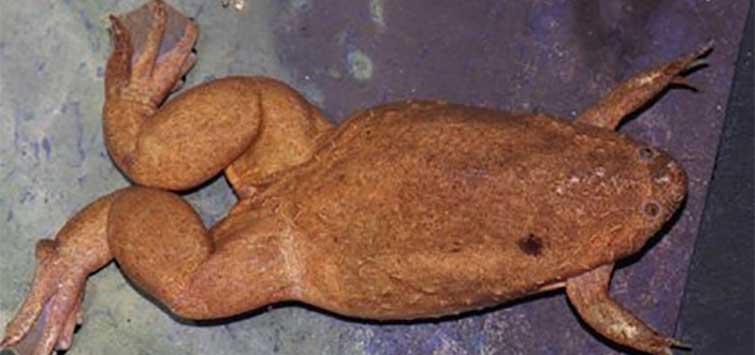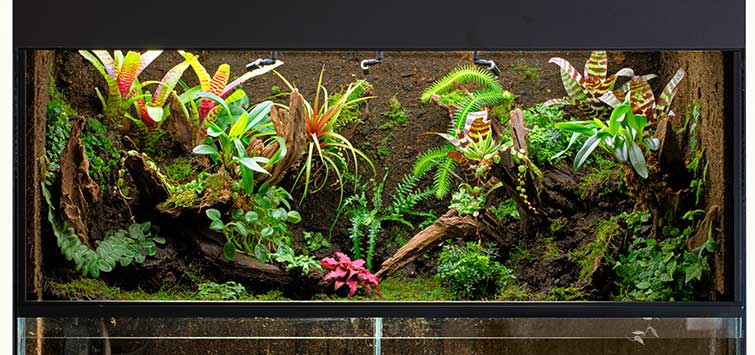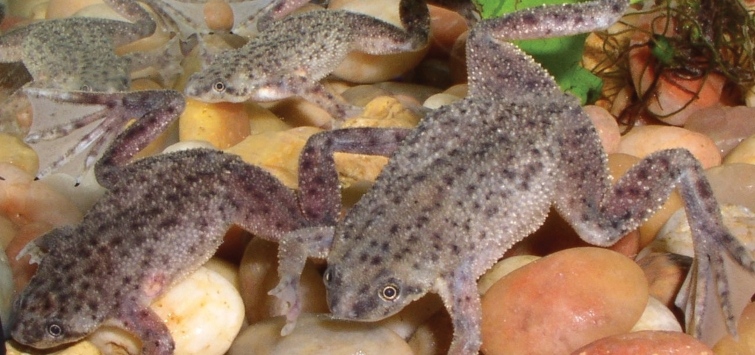Silurana Clawed Frogs
Author: Colin Dunlop
Aquatic frogs can entertain and fascinate their keepers with underwater antics and interesting breeding behaviors. An experienced amphibian enthusiast relates his story of maintaining and breeding a clawed frog that is relatively new to the aquarium hobby.
My Experience with Clawed Frogs
Like most people who have an interest in keeping tropical fish, I have, on occasion, kept other aquatic animals. I have looked after cephalopods, shrimps, crabs, snails, turtles, and amphibians such as newts, salamanders, and—more particularly—clawed frogs. I think it’s great that there are currently many non-fish animals available to keep in aquariums, and that clawed frogs have developed such a strong following.
First Try
The first time I kept clawed frogs was in the late 1980s when I was about 13 or 14. I bought one from a local fish shop, with very little useful information, and the frog was about 1¼-inch long. I initially kept it in a 3-foot-long community tank with various tropical fish such as platys and tetras. But just like most people who buy clawed frogs, I learned about their eating habits the hard way and, one by one, some of my smaller fish started to mysteriously disappear. It didn’t take too long to figure out where the fish were going due to the rapidly expanding belly of the frog, but rather than being banished back to the shop, the frog was kept and given a tank of its own where it grew to a good 4 inches in length, becoming a firm favorite of mine and a real pet. That particular species of clawed frog was Xenopus laevis, the most commonly available species, especially the albino morph.
Finding More Amphibians
In 2000 I once again took to the notion of keeping amphibians and was very excited to learn there were other new species of Xenopus available for sale, and that they were relatively easy to track down. Xenopus laevis is still by far the most commonly seen member of the genus, but I quickly managed to get my hands on several different species such as X. muelleri, X. fraseri, X. boumbaensis, and X. borealis. I also managed to track down a couple of species of frog that once belonged to the Xenopus genus but were later moved into a new genus called Silurana.
Finding Silurana Frogs
The best thing about the Silurana genus of clawed frogs is that their husbandry requirements lie somewhere in between the other two most commonly seen frogs offered for sale. They are larger and more active than the diminutive Hymenochirus species (dwarf African frogs) and are smaller than Xenopus laevis (African clawed frogs).
I originally managed to get my hands on four Silurana from a local importer selling them with the useless name “brown frog.” I couldn’t identify them at the time, but I could tell in the shop that they were something a little different, as they had tiny little eyes and a more olive coloration compared to the usual brown frogs that generally turn out to be the wild coloration of Xenopus laevis. It wasn’t until I got home and did some research that I discovered they were Silurana.
Silurana tropicalis?
The species I got that day is most probably Silurana tropicalis. I am reasonably sure that my other colony of Silurana, which I got later in 2002, are S. epitropicalis partly because of the morphological differences between the two groups, and partly because of the noise the males make during courtship. The only way to know for sure would be to send a tissue sample to a specialist for DNA analysis, but for the purpose of this article I’ll just refer to my frogs as Silurana tropicalis. If anyone knows any better from the pictures, then please tell me.
The collection location for the frogs would be useful in determining the species, but the best I could get from the importer was Nigeria, and they very well may have been collected in another country before being shipped from Nigeria. The frog’s natural distribution covers a wide area in the western central Africa region, and the species is very adaptable to different habitats from savannahs to rainforests.
Behind the Name
Clawed frogs get their name from the claws on their back feet. They use these claws when they are feeding to tear pieces of food into manageable sizes for swallowing. If you ever have to catch and hold a large Xenopus, these claws will be quite obvious as they squirm and scratch your hand. They won’t do any real damage to you, but it is certainly quite uncomfortable—especially if they get a lucky stab under a fingernail! The claws are also useful for identification purposes, as X. laevis has three claws while Silurana species have four. There are some species of Xenopus that have four claws, such as X. fraseri, but at the very least, counting four claws will tell you that they are not X. laevis. You’ll need to do further research to identify your frogs once you get them home from the shop. The extra claw you are looking for is the highest on the foot, almost as if where the heel would be on a human foot. They should be obvious because they are black against the lighter-colored skin.
General Husbandry
Long-term aquarium care for the frogs is really not difficult. Some of my individuals are on their ninth or tenth year with me and were of an adult size when I got them, so they could be even older. A typical fish tank is ideal for covering all their needs, and for a group of half a dozen frogs you will need a tank in the region of 25 x 10 x 10 inches. These frogs are aquatic, so you don’t need to worry about having a land section, but as Silurana can often be found basking, they appreciate a floating piece of polystyrene or plants like Amazon frogbit to lie across. They will quickly dart into the water when they see you coming, and it’s rare to be able to sneak up on one out of the water.
Water Conditions
The water should be at least 6 inches deep and kept at about 72° to 79°F, as they truly are tropical—unlike some Xenopus species, which can survive down to freezing temperatures. The pH doesn’t seem to be important to the frogs because I have had them in water ranging from pH 3 to 8 over the years, as my water is so soft the pH can quickly drop. There is never any obvious change in their habits or feeding with regards to the pH, so I generally tend not to bother checking anymore. You will need to use some form of filtration in the tank—I tend to use air-operated sponge filters, so for them to work biologically the pH should be above 6. You really do need a tight-fitting lid, as they have been known to try and leave the tank.
Decor
I do feel it is important to offer the frogs some enrichment in their lives, which is very simple to achieve. Offer the frogs some cover in the form of floating plants, some submerged aquarium plants, a sand substrate, and a cave or two made from clay flowerpots or pipes they can hide in if they want.
Feeding
Feeding these guys presents no problem, as anything is fair game and will be tried at least once. Variety is the spice of life and my frogs get a mixture of earthworms, bloodworms, raw squid, crickets, and a pellet food specially made for clawed frogs. Don’t feed them every day because they will get fat quickly and health problems may develop. In fact, my frogs are at most fed twice a week and often even skip a week.
Breeding
Getting these frogs to breed was something I had to work at over a couple of years and initially failed to achieve. The procedure that eventually worked for me could almost be described as neglect! The frog’s filter was removed, the temperature was raised to 86°F, the tank was allowed to get mucky, and I let the water evaporate. This was essentially to try and mimic a dry season where the frog’s ponds were drying up and becoming more and more stagnant. I threw some food in from time to time, but there was no regular regimen.
This was kept up for approximately three months, and then the tank had a 100-percent water change with fresh water that had been allowed to sit overnight. The new water was much cooler at only 65°F and the filter was reinstated and set to bubble quite vigorously. I then carried out 50-percent water changes with new prepared water every couple of days.
Courting
Within a few days the male frogs started making their typical clicking noises to attract the females and could often be heard even from outside my fishroom. I was stuffing them full of live earthworms and crickets, and the feeding activity became more and more enthusiastic as the frogs became more active. The males in particular started skimming the surface, presumably for more food. Once I saw a male grabbing a female around the waist in a position called amplexus, I guessed that spawning wasn’t too far away and separated a male and female into their own tank. The sexes were very obvious at this time, as the female is about 25 percent larger than the male, has a swollen cloaca, and the male’s “forearms” become thickened and covered in black, rough skin to aid them in holding onto the female’s slippery waist.
Spawning Tank
The spawning tank was a bare-bottomed 30 x 10 x 10 inches and filled three-quarters full with new water at a temperature of 77°F and pH 6.5. I added a couple of spawning mops and a clump of Java moss, as hopefully this is where the eggs would be laid. There was light filtration supplied with a sponge filter. I added the frogs in the early afternoon and didn’t have to wait too long to see the frogs in amplexus or for the start of actual spawning. I grabbed my camera to record the process.
Spawning
Amplexus in frogs can vary depending on the species and, in the case of Silurana, the frogs use a lumbar amplexus, which is when the male holds the female around her waist in a position much farther back than we commonly see in the ranid frogs that most of us will be familiar with. The pair starts lying on the bottom of the tank and then rises to the surface, where they perform the start of a backward somersault. When the pair is at the surface of the water and at the highest part of the loop, they are upside down. This is when the male curves his body up and under the female’s cloaca to fertilize the eggs that are now being released. One or both of the frogs will now start kicking their legs, which should help in fertilizing the eggs, and then they complete the loop and head back to the bottom of the tank. The whole process may last about five seconds.
Raising Tadpoles
The eggs are laid singly, are sticky, and—as they sink to the bottom of the tank—adhere to anything they touch, which includes the spawning mops or even the frogs themselves. I left the frogs for the entire night in the dark and by the next morning, the pair had separated and there looked to be several thousand eggs scattered across the aquarium and its surfaces. The adults were removed right away to stop them from eating the eggs.
Hatching Eggs
Amazingly, by the end of the first day the eggs started to hatch. It only took about 24 hours for all of the tadpoles to hatch and hang on the surface film, the walls of the aquarium, and the spawning mops. Initially, they look like little gray-colored commas. It takes about two days for the tadpoles to become free-swimming, and it was at this time that I started feeding them. Just like Xenopus tadpoles, the Silurana tadpoles are filter feeders and adopt a tail-up, head-down position in the water column as they continually filter water through their mouths to pick up minute traces of food. You can buy purpose-made tadpole food, but I have found that fish flake finely crushed in a mortar and pestle works just as well to begin with. Finely powdered spirulina and liquid fish-fry food also seems to get the tadpoles started okay.
Growth
The tadpoles grow quickly and initially look like livebearing fish’s fry, but they later take on quite a bizarre appearance, especially after a couple of weeks when the back legs start to appear. It wasn’t too long before the tadpoles had to be thinned out a bit and put into separate tanks with siblings of a similar size. The first froglets appeared within four weeks and, at this time, some of the tadpoles had yet to develop back legs, so there seems to be quite a variation in metamorphosis time. Once a tadpole has its front legs pop through, it is best to move it to another tank because it will begin preying on its younger siblings who are still tadpoles. The froglets can grow quickly and are sexually mature in only six months—about half the time for Xenopus species.
I have bred these frogs on several occasions now and they are fun to watch, and although the tadpoles are often very time-consuming to rear, it is very satisfying.
Check Your Local Regulations
Lastly, it is worth noting that Xenopus species are controlled in some parts of the world, including some states in the United States, so please make sure you are aware of any legal implications before getting some of these frogs. This is partly because of the destructive effect these predatory aquatic frogs can have on a habitat without any controlling factor on them, and secondly, Xenopus frogs can be carriers of a fungus called Batrachochytrium dendrobatidis. This causes the disease chytridiomycosis, which—if introduced to a population of wild frogs—could potentially wipe out entire areas of amphibians while the Xenopus or Silurana themselves remain unaffected.
See the full article on TFH Digital http://www.tfhdigital.com/tfh/200910/#pg83

.png?h=595&iar=0&w=2781&hash=5FD5E69473BCC22199FBFA2FB71B6033)



